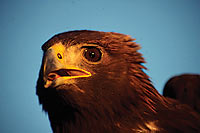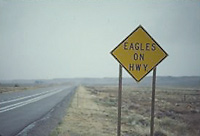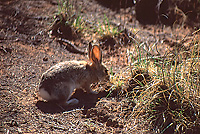Spring lifts the wrap of winter early in the Canyon Country. But even as the temperatures rise and the snow levels retreat, there are wildlife already pairing up. Great horned owls and Canada geese may have jump started the season and already be on eggs as March wakes up, but one of the big desert birds – the golden eagle – is just starting to “sky dance.”
Named after the golden or blond-colored head feathers, golden eagles are a common desert dwelling species that utilizes rocky cliffs for nest sites and small mammal populations for prey. The birds build huge stick nests on some high rocky ledge with an expanse view Here, they’ll try to raise one to three young, but it’s a long process starting in spring. The largest nest on record was 8.5 feet wide and 20 feet tall!
When the eagles start to initiate a roller-coaster flight, a pattern called “sky-dancing,” this is a good indicator that the birds are defending their territories and the breeding season is underway. This can start early in the year and extend on into spring. The undulating flight serves as a visual ‘This Space is Taken’ warning to other golden eagles or raptors when they enter into the breeding bird’s air space.
Throughout the year, golden eagles hunt prey from small mammals to carrion. They’ll take waterfowl, rabbits, jackrabbits, prairie dogs, newborn deer or pronghorn (especially sick or injured ones), and I’ve even seen an eagle harass an osprey until that bird dropped its fish prey which the eagle then dove for and snagged out of the air. 
During years of explosive prairie dog populations in the Cisco Desert, the eagles feast on road kills along Interstate 70. Unfortunately, some eagles also become fatalities during this time as they can’t lift off quickly enough to avoid a vehicle collision. Signs and reduction of perching points on power poles along the highway have helped; hence the ‘Eagles on Highway’ warning signs along the road.
With a massive six-foot wingspan, these birds need some time and space to get airborne. Once aloft, they can fly directly or soar high above the ground in search of prey or potential danger. From below, the adults show off dark wings, but immature or second year birds have white patches on their undersides and some white on their tail. Sometimes confused for bald eagles, the darker head coloration for the goldens is a good field mark compared to the white head of an adult bald eagle. Both species occur out in the Cisco Desert where prey is abundant and, sometimes, easy pickings.
One behavior the golden eagles engage in is called “mantling.” If they catch prey on the ground, the birds may shadow their prey by spreading their wings wide. Kind of a “nothing under here to look at” posture. Knowing their relatives to be “eagle-eyed” the successful hunter is trying to keep the prey to themselves.
Special legislation under the Bald and Golden Eagle Protection Act was enacted in 1962 to protect these magnificent birds from illegal activities. As a top tier predator, declines in populations of bald or golden eagles signals an imbalance in their life histories or the environments they inhabit. But, as guardians of their galaxy, we can ensure that future generations may enjoy these sky-dancing birds.